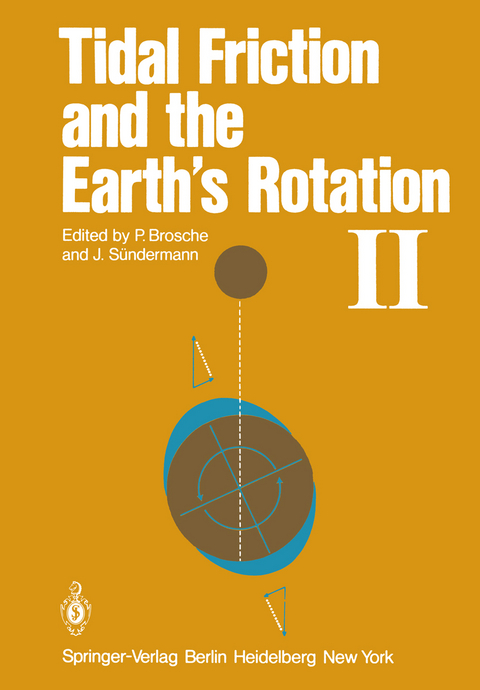
Tidal Friction and the Earth’s Rotation II
Springer Berlin (Verlag)
978-3-540-12011-7 (ISBN)
Julius Robert Mayer's Ideas oil a Theory of Tidal Friction.- Tidal Friction Parameters from Satellite Observations.- 1. Introduction.- 2. Tidal Perturbations on Satellites Orbits.- 3. Global Ocean Tide Models.- 4. Lunar Tidal Deceleration and Tidal Earth' Q.- 5. Lunar Laser Ranging Results.- References.- On Some Topical Problems of the Dynamics of the Earth-Moon System.- 1. Introduction.- 2. The Earth-Moon Force Function.- 3. The Effect of R?c on the Earth's Rotation Dynamics.- 4. Theoretical Non-Tidal Acceleration in the Moon's Mean Motion on the Basis of Celestial Mechanics and the Non-Tidal Acceleration in the Earth's Rotation.- 5. Other Phenomena.- 6. Conclusion.- References.- History of the Earth's Rotation Since 700 B.C..- 1. Introduction.- 2. The Lunar Acceleration (n).- 3. Analyses of Telescopic Observations: 1620-1978.- 4. Medieval Fluctuations.- 5. Analysis of Ancient Observations.- 6. Geophysical Implications.- References.- Deceleration of the Earth's Rotation from Old Solar Observations.- 1. Introduction.- 2. Analysis of Solar Tables.- 3. The Length of the Year (Motion Comparison).- 4. Conclusions.- References.- Long Time Integration of the Moon's Orbit.- 1. Introduction.- 2. Physical Processes: A Qualitative Analysis.- 4. Conclusion.- Appendix I. The Present Status of the Gravitational Secular Acceleration.- Appendix II. Precessional Equations.- References.- The Earth's Non-Uniform Rotation.- 1. Introduction.- 2. Angular Momentum of the Atmosphere.- 3. The Decade Variations in the Length of the Day and Core-Mantle Coupling.- References.- The Rotation and the Magnetic Field of the Earth.- 1. Introduction.- 2. Weak or Strong Toroidal Fields?.- 3. Electromagnetic Core-Mantle Coupling.- References.- Gravitational Heating of JovianSatellites by Tidal Friction.- References.- Balance Problems in Tidal Computations.- 1. Introduction.- 2. Theoretical Considerations.- 3. Numerical Estimates.- 4. Conclusions.- References.- The Resonance Behavior of the World Ocean.- 1. Introduction.- 2. Tidal Resonance and Momentum Transfer.- 3. The Eigen Modes of the Present Ocean.- 4. Conclusions for the History of the Oceans.- References.- Tidal Friction for Times Around the Presence.- 1. Introduction.- 2. Extension of the Hydro dynamic-Numerical Model.- 3. Results.- 4. Conclusions.- References.- Paleotides Before the Permian.- 1. Introduction.- 2. Method.- 3. Results.- 4. Discussion.- 5. Summary.- References.- On the Reduction in Tidal Dissipation Produced by Increases in the Earth's Rotation Rate and Its Effect on the Long-Term History of the Moon's Orbit.- 1. Introduction.- 2. The Ocean Model.- 3. The Astronomical Model.- 4. Results.- 5. Discussion.- References.- A Note on the Variability of Growth Increment Formation in the Shell of the Common Cockle Cerastoderma edule.- 1. Introduction.- 2. Different Types of Growth Patterns.- 3. Material and Method.- 4. Observations.- 5. Discussion.- References.- Paleogeography and Paleobathymetry: Quantitative Reconstructions of Ocean Basins.- 1. Introduction.- 2. Paleogeographic Reconstructions.- 3. Paleobathymetric Reconstructions.- 4. An Example: The Tertiary Atlantic Ocean.- References.- Mesozoic and Cenozoic Paleogeographic Maps.- 1. Introduction.- 2. Continental Fits.- 3. Paleomagnetic Orientations.- 4. Convergent Zones.- 5. Conclusions.- References.- Movements of the Continental Crust and Lithosphere-Aestenosphere Systems in Precambrian Times.- 1. Introduction.- 2. The Proterozoic Supercontinent.- 3. The Precambrian a.p.w. Path.- 4. Geophysical Implications of thePrecambrian Palaeomagnetic Record.- 5. Continental Concolidation and Lithosphere Development.- 6. Shelf Seas in Precambrian Times.- References.- Chemical and Isotopic Evidence for the Early History of the Earth-Moon System.- 1. Introduction.- 2. Basalts from Four Planets.- 3. Correlated Elements.- 4. Chemistry and Formation of Earth and Moon.- 5. Origin of the Moon.- References.- Concluding Remarks.
| Erscheint lt. Verlag | 1.1.1982 |
|---|---|
| Zusatzinfo | XVI, 348 p. 30 illus. |
| Verlagsort | Berlin |
| Sprache | englisch |
| Maße | 170 x 244 mm |
| Gewicht | 680 g |
| Themenwelt | Naturwissenschaften ► Biologie ► Ökologie / Naturschutz |
| Naturwissenschaften ► Geowissenschaften ► Geologie | |
| Naturwissenschaften ► Geowissenschaften ► Geophysik | |
| Naturwissenschaften ► Physik / Astronomie ► Angewandte Physik | |
| Technik ► Umwelttechnik / Biotechnologie | |
| Schlagworte | Atlantic Ocean • Atmosphere • Cambrian • Development • Energy • Environment • Formation • growth • Lithosphere • Magma • Ordovician • Permian • Proterozoic • shelf seas • supercontinent |
| ISBN-10 | 3-540-12011-4 / 3540120114 |
| ISBN-13 | 978-3-540-12011-7 / 9783540120117 |
| Zustand | Neuware |
| Haben Sie eine Frage zum Produkt? |
aus dem Bereich


